+ Open data
Open data
- Basic information
Basic information
| Entry | Database: EMDB / ID: EMD-8491 | |||||||||
|---|---|---|---|---|---|---|---|---|---|---|
| Title | E. coli CTP synthase CC mutant filament | |||||||||
 Map data Map data | E. coli CTP synthase CC mutant filament | |||||||||
 Sample Sample |
| |||||||||
| Function / homology |  Function and homology information Function and homology informationcytoophidium / CTP synthase (glutamine hydrolysing) / CTP synthase activity / 'de novo' CTP biosynthetic process / pyrimidine nucleobase biosynthetic process / glutaminase activity / CTP biosynthetic process / glutamine metabolic process / protein homotetramerization / magnesium ion binding ...cytoophidium / CTP synthase (glutamine hydrolysing) / CTP synthase activity / 'de novo' CTP biosynthetic process / pyrimidine nucleobase biosynthetic process / glutaminase activity / CTP biosynthetic process / glutamine metabolic process / protein homotetramerization / magnesium ion binding / protein-containing complex / ATP binding / identical protein binding / cytosol Similarity search - Function | |||||||||
| Biological species |  | |||||||||
| Method | helical reconstruction / cryo EM / Resolution: 8.6 Å | |||||||||
 Authors Authors | Lynch E / Kollman J | |||||||||
 Citation Citation |  Journal: Nat Struct Mol Biol / Year: 2017 Journal: Nat Struct Mol Biol / Year: 2017Title: Human CTP synthase filament structure reveals the active enzyme conformation. Authors: Eric M Lynch / Derrick R Hicks / Matthew Shepherd / James A Endrizzi / Allison Maker / Jesse M Hansen / Rachael M Barry / Zemer Gitai / Enoch P Baldwin / Justin M Kollman /   Abstract: The universally conserved enzyme CTP synthase (CTPS) forms filaments in bacteria and eukaryotes. In bacteria, polymerization inhibits CTPS activity and is required for nucleotide homeostasis. Here we ...The universally conserved enzyme CTP synthase (CTPS) forms filaments in bacteria and eukaryotes. In bacteria, polymerization inhibits CTPS activity and is required for nucleotide homeostasis. Here we show that for human CTPS, polymerization increases catalytic activity. The cryo-EM structures of bacterial and human CTPS filaments differ considerably in overall architecture and in the conformation of the CTPS protomer, explaining the divergent consequences of polymerization on activity. The structure of human CTPS filament, the first structure of the full-length human enzyme, reveals a novel active conformation. The filament structures elucidate allosteric mechanisms of assembly and regulation that rely on a conserved conformational equilibrium. The findings may provide a mechanism for increasing human CTPS activity in response to metabolic state and challenge the assumption that metabolic filaments are generally storage forms of inactive enzymes. Allosteric regulation of CTPS polymerization by ligands likely represents a fundamental mechanism underlying assembly of other metabolic filaments. | |||||||||
| History |
|
- Structure visualization
Structure visualization
| Movie |
 Movie viewer Movie viewer |
|---|---|
| Structure viewer | EM map:  SurfView SurfView Molmil Molmil Jmol/JSmol Jmol/JSmol |
| Supplemental images |
- Downloads & links
Downloads & links
-EMDB archive
| Map data |  emd_8491.map.gz emd_8491.map.gz | 116.1 MB |  EMDB map data format EMDB map data format | |
|---|---|---|---|---|
| Header (meta data) |  emd-8491-v30.xml emd-8491-v30.xml emd-8491.xml emd-8491.xml | 9.4 KB 9.4 KB | Display Display |  EMDB header EMDB header |
| Images |  emd_8491.png emd_8491.png | 56.5 KB | ||
| Archive directory |  http://ftp.pdbj.org/pub/emdb/structures/EMD-8491 http://ftp.pdbj.org/pub/emdb/structures/EMD-8491 ftp://ftp.pdbj.org/pub/emdb/structures/EMD-8491 ftp://ftp.pdbj.org/pub/emdb/structures/EMD-8491 | HTTPS FTP |
-Validation report
| Summary document |  emd_8491_validation.pdf.gz emd_8491_validation.pdf.gz | 79.1 KB | Display |  EMDB validaton report EMDB validaton report |
|---|---|---|---|---|
| Full document |  emd_8491_full_validation.pdf.gz emd_8491_full_validation.pdf.gz | 78.2 KB | Display | |
| Data in XML |  emd_8491_validation.xml.gz emd_8491_validation.xml.gz | 494 B | Display | |
| Arichive directory |  https://ftp.pdbj.org/pub/emdb/validation_reports/EMD-8491 https://ftp.pdbj.org/pub/emdb/validation_reports/EMD-8491 ftp://ftp.pdbj.org/pub/emdb/validation_reports/EMD-8491 ftp://ftp.pdbj.org/pub/emdb/validation_reports/EMD-8491 | HTTPS FTP |
-Related structure data
| Related structure data |  8474C  8475C  8476C  8490C  8504C  8513C 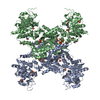 5tkvC  5u03C  5u05C  5u3cC  5u6rC C: citing same article ( |
|---|---|
| Similar structure data |
- Links
Links
| EMDB pages |  EMDB (EBI/PDBe) / EMDB (EBI/PDBe) /  EMDataResource EMDataResource |
|---|---|
| Related items in Molecule of the Month |
- Map
Map
| File |  Download / File: emd_8491.map.gz / Format: CCP4 / Size: 125 MB / Type: IMAGE STORED AS FLOATING POINT NUMBER (4 BYTES) Download / File: emd_8491.map.gz / Format: CCP4 / Size: 125 MB / Type: IMAGE STORED AS FLOATING POINT NUMBER (4 BYTES) | ||||||||||||||||||||||||||||||||||||||||||||||||||||||||||||||||||||
|---|---|---|---|---|---|---|---|---|---|---|---|---|---|---|---|---|---|---|---|---|---|---|---|---|---|---|---|---|---|---|---|---|---|---|---|---|---|---|---|---|---|---|---|---|---|---|---|---|---|---|---|---|---|---|---|---|---|---|---|---|---|---|---|---|---|---|---|---|---|
| Annotation | E. coli CTP synthase CC mutant filament | ||||||||||||||||||||||||||||||||||||||||||||||||||||||||||||||||||||
| Projections & slices | Image control
Images are generated by Spider. | ||||||||||||||||||||||||||||||||||||||||||||||||||||||||||||||||||||
| Voxel size | X=Y=Z: 1.26 Å | ||||||||||||||||||||||||||||||||||||||||||||||||||||||||||||||||||||
| Density |
| ||||||||||||||||||||||||||||||||||||||||||||||||||||||||||||||||||||
| Symmetry | Space group: 1 | ||||||||||||||||||||||||||||||||||||||||||||||||||||||||||||||||||||
| Details | EMDB XML:
CCP4 map header:
| ||||||||||||||||||||||||||||||||||||||||||||||||||||||||||||||||||||
-Supplemental data
- Sample components
Sample components
-Entire : E. coli CTP synthase CC mutant filament
| Entire | Name: E. coli CTP synthase CC mutant filament |
|---|---|
| Components |
|
-Supramolecule #1: E. coli CTP synthase CC mutant filament
| Supramolecule | Name: E. coli CTP synthase CC mutant filament / type: complex / ID: 1 / Parent: 0 / Macromolecule list: #1 Details: Disulfide-crosslinked E. coli CTP synthase filaments assembled in non-reducing buffer; substrates UTP and ATP added after filament assembly |
|---|---|
| Source (natural) | Organism:  |
| Recombinant expression | Organism:  |
-Experimental details
-Structure determination
| Method | cryo EM |
|---|---|
 Processing Processing | helical reconstruction |
| Aggregation state | filament |
- Sample preparation
Sample preparation
| Concentration | 0.15 mg/mL |
|---|---|
| Buffer | pH: 8 |
| Vitrification | Cryogen name: ETHANE |
| Details | Filaments were assembled by dialysis into non-reducing buffer (50 mM Na-HEPES pH 8.0), and then incubated with MgCl2 (10 mM), UTP (0.6 mM), and ATP (1.5 mM). |
- Electron microscopy
Electron microscopy
| Microscope | FEI TECNAI F20 |
|---|---|
| Image recording | Film or detector model: GATAN K2 SUMMIT (4k x 4k) / Detector mode: COUNTING / Average electron dose: 45.0 e/Å2 |
| Electron beam | Acceleration voltage: 200 kV / Electron source:  FIELD EMISSION GUN FIELD EMISSION GUN |
| Electron optics | Illumination mode: OTHER / Imaging mode: BRIGHT FIELD |
| Experimental equipment |  Model: Tecnai F20 / Image courtesy: FEI Company |
- Image processing
Image processing
| Final reconstruction | Applied symmetry - Helical parameters - Δz: 83.5 Å Applied symmetry - Helical parameters - Δ&Phi: 50.6 ° Applied symmetry - Helical parameters - Axial symmetry: C2 (2 fold cyclic) Resolution.type: BY AUTHOR / Resolution: 8.6 Å / Resolution method: FSC 0.143 CUT-OFF / Software: (Name: SPIDER, hsearch_lorentz) / Number images used: 7135 |
|---|---|
| CTF correction | Software - Name: CTFFIND |
| Startup model | Type of model: OTHER / Details: Cylinder |
| Final angle assignment | Type: NOT APPLICABLE / Software - Name: SPIDER |
 Movie
Movie Controller
Controller



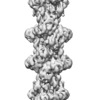



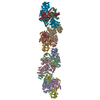
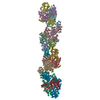

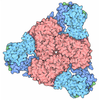

 Z (Sec.)
Z (Sec.) Y (Row.)
Y (Row.) X (Col.)
X (Col.)





















